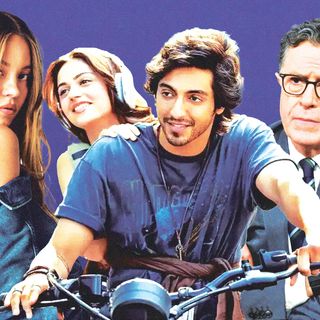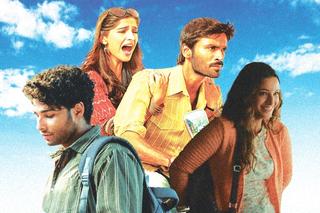
On Happily Ever Afters
Just because we want them, does it mean we deserve them?

Present Tense is The Swaddle Team's stream of consciousness response to the world's madness.
Today we're going to talk about the movies: two in particular, both of which have to do with an apparent market requirement for happy endings. The first is Raanjhanaa, a 2013 Hindi film directed by Aanand L. Rai and starring Dhanush and Sonam Kapoor in the lead. Spoiler alert: he dies in the end. So the production company, Eros, is about to re-release the film in theatres with an AI-altered, "happier" ending. Indian copyright law bestows authorship of a film on a producer -- leaving the director with no say in whether they'd want their movie changed so fundamentally or not.
As everybody has noted, this has raised serious but recursive questions about the perils of AI in creative industries, AI cheapening art, AI being uselessly deployed to mess with movies instead of doing taxes, etc. But if this is really happening, and it looks like it is, it's not really an AI problem that the market seems to want to sell happier stories, is it?
The second movie is Dhadak 2, directed by Shazia Iqbal and starring Siddhant Chaturvedi and Triptii Dimri in the lead. This is a remake of the Tamil film Pariyerum Perumal, directed by Mari Selvaraj. In the original film, the plot revolves around a man who is unable to engage with human pursuits of love and romance due to the ugly, daily interruptions of caste. It's about the fact that caste withholds a person from even having the bandwidth to think about such quotidian matters as love. The protagonist cannot make up his mind about his feelings for a dominant caste woman who is in love with him, because her family is just so bent on destroying him for even entertaining the notion – an extraordinarily irregular interruption to an otherwise universal dilemma about feelings. In Dhadak 2, we get a happy ending.
You've heard of the MCU, you've heard of DC – now get ready for DCU, the Dhadak Cinematic Universe. Because why is it named Dhadak 2? The predecessor of this film, Dhadak, was a remake of an entirely different movie -– Sairaat, a Marathi film by Nagraj Manjule. In other words, both Dhadaks are remakes of two completely separate films, in different languages, made and produced by different people. Why then are they being sold as sequels of one another despite having nothing in common? Nothing in common, that is, except for caste. There is no reason for there to exist a franchise of caste-related movies, and yet here we are.
Although, per early reviews, it seems that Dhadak 2 is not making the same mistake as its predecessor. In that it responded to the criticism Dhadak received and is not shying away from broaching caste. On the upside, it's one of the first mainstream Bollywood theatrical releases in recent times to get into it. On the downside, they did brownface their actors (of the two, the former is a bigger surprise). Another thing that stands out about Dhadak 2, promoted as a story of star-crossed lovers (or "caste-crossed" lovers as one website put it), is that it allows a hopeful ending where the original film left it ambiguous at best. Yes, adaptations are allowed to take creative liberties and strict loyalty to the source material does not always augur an honest film. But this all boils down to the question we always ask about the movies: do we want them to move us or to relieve us? In short: mirror or fantasy?
We appear to be in the era of magical thinking. In a world like this, love must conquer all. It must win no matter what. The world is rapidly hurtling towards its own destruction, and the only way to cope is to escape into a fantasy where nothing bad can permanently alter or hurt us. Does this give production houses license to change narratives about reality just because we don't want them to be true? Because let's face it, the caste-crossed lovers of today's India are scarcely allowed happy endings — or even ambiguous ones. Also, why can't we just make new movies instead? Culturally, we've established that the author is dead — hence the fan-fiction-ification of books, and now films. Hence the concept of cover artists. These aren't bad things, and one might even argue that it's good to have the ability to play with beloved stories and make them your own. But in specifically reimagining happier endings, do we lose the whole human condition thing that's intrinsic to art?
There's also the fact that happiness cannot be divorced from the cultural context: every single facet of life today is optimized for giving us spurts of dopamine, a temporary and cheap type of satisfaction that doesn't last long. Now we're tinkering with the things designed for a different purpose -- to inspire pathos, an important feeling in the pantheon of human emotions. And also, could happiness also acts as a shield when it comes to confronting ugly truths? Because while love may triumph over caste violence in fiction, in reality it's only been a week since a 23-year-old Dalit man in Tamil Nadu was murdered, allegedly by his girlfriend's brother. You could argue that mainstream depictions of inter-caste love might help change hearts and minds, but you'd most likely be preaching to the choir. And it doesn't change the fact that the aim of this type of savage casteism is preventative -– to nip such romance in the bud – a subtler point that could only be made with an ending like the one in Pariyerum Perumal.
As for AI: can it change the ending of real life instead, please?
Related


The Internet Loves a Good Scandal
